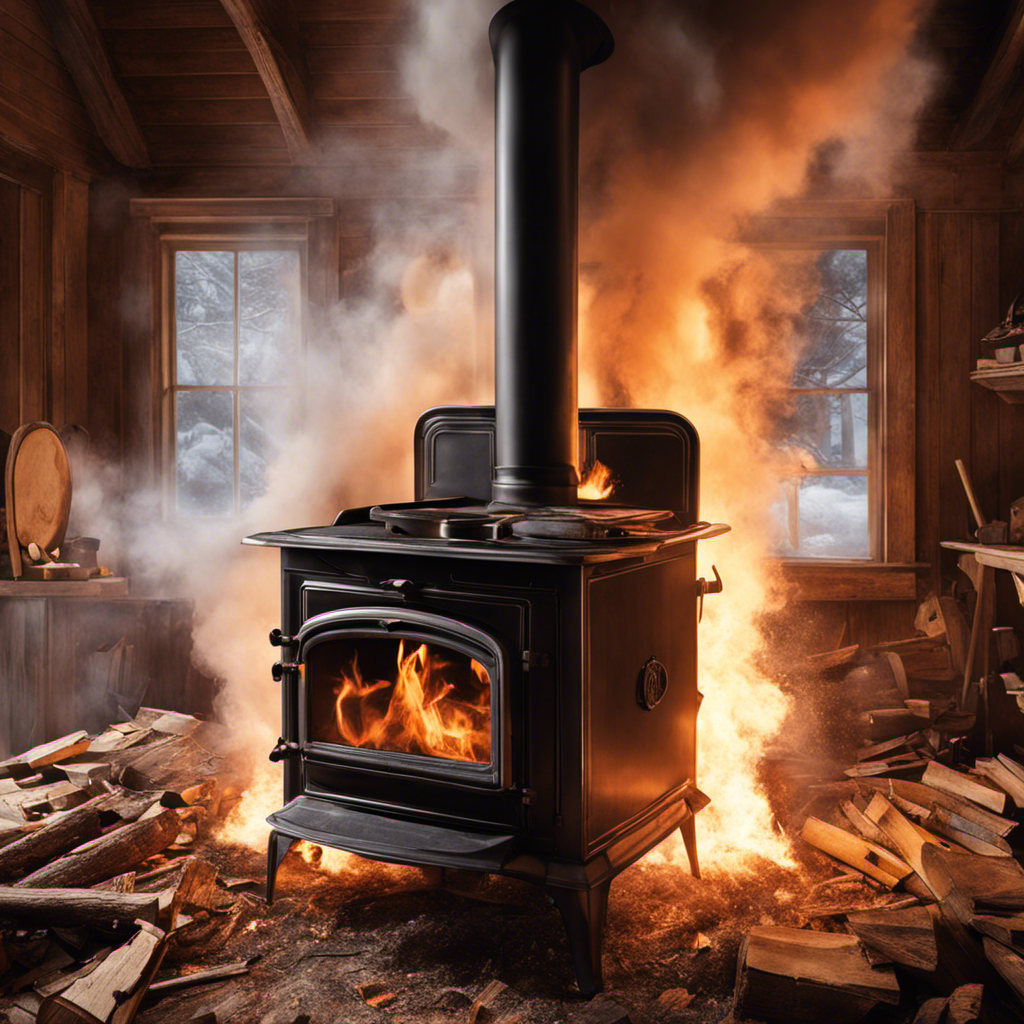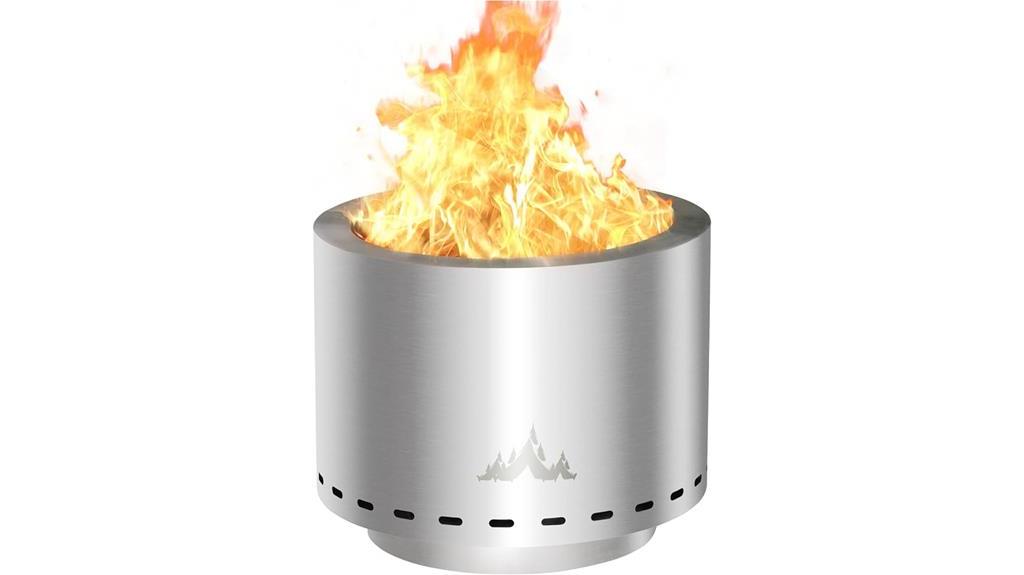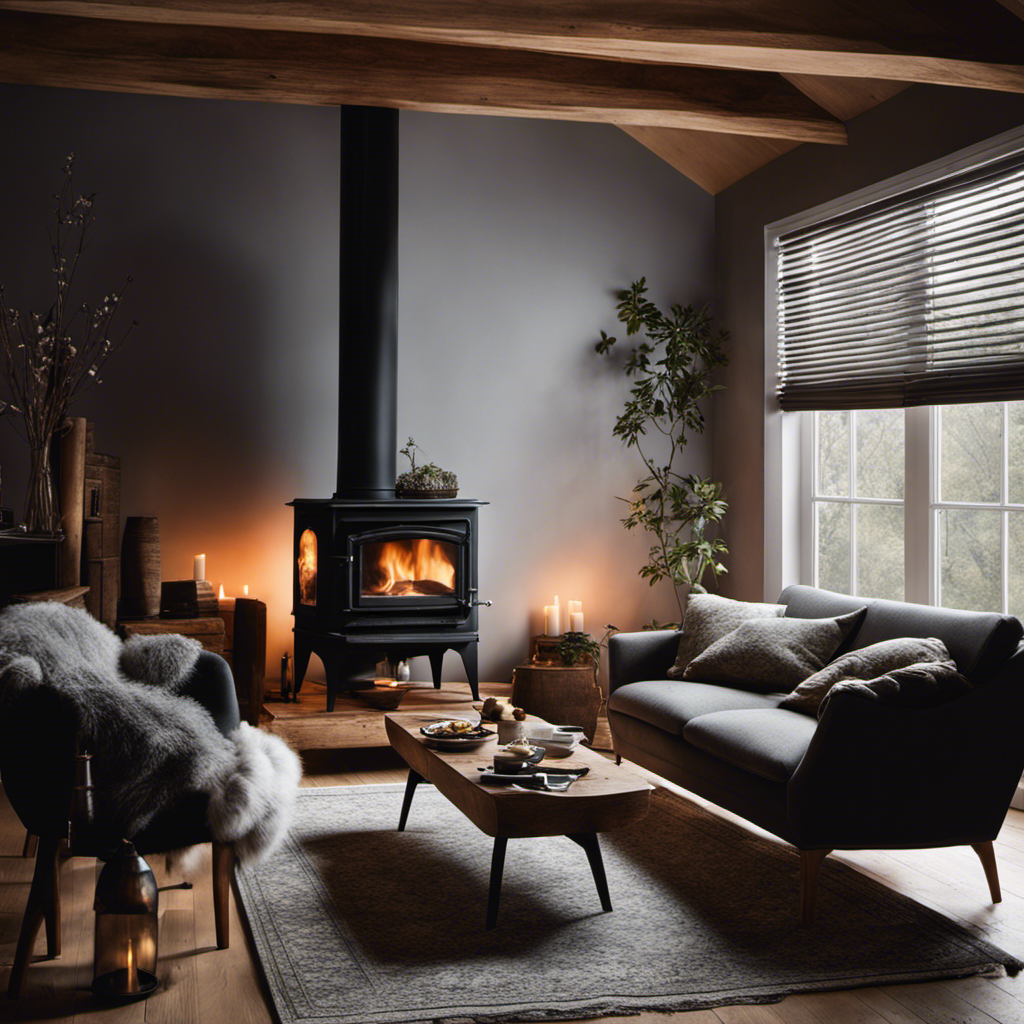The first time I heard a loud noise similar to an explosion coming from my wood stove, it surprised me and made me feel worried. However, I soon discovered that this is a common problem that many wood stove users experience.
In this article, I will delve into the reasons why wood stoves can sound like they’ve had an explosion, including the impact of airflow, moisture, and poor maintenance.
I will also provide valuable tips on how to prevent and resolve these unsettling noises.
Key Takeaways
- Restricted airflow and inadequate ventilation can lead to gas buildup and pressure inside the wood stove, increasing the risk of explosions.
- Extreme temperature changes and stress on the stove materials can contribute to structural weaknesses and potential explosions.
- High moisture content in wood can cause incomplete combustion and pressure buildup, resulting in explosion-like noises.
- Poor maintenance, including neglecting regular cleaning, ignoring signs of damage, and using improper fuel, significantly increases the likelihood of wood stove explosions.
Common Causes of Explosive Sounds in Wood Stoves
I’ve been researching the common causes of explosive sounds in wood stoves, and it seems like improper airflow is often to blame.
When the airflow in a wood stove is restricted, it can lead to a buildup of gases and pressure inside the stove. As the temperature rises, these gases can ignite suddenly, causing a loud and potentially dangerous explosion.
This is why it’s crucial to ensure proper installation of the wood stove, including proper ventilation and chimney placement, to allow for adequate airflow.
Additionally, the impact of temperature on wood stove explosions can’t be ignored. Extreme temperature changes can cause stress on the materials of the stove, leading to cracks or other structural weaknesses that can contribute to explosions.
Understanding the Impact of Airflow on Wood Stove Explosions
How does airflow affect the occurrence of wood stove explosions? Understanding airflow patterns is crucial when examining combustion processes in wood stoves. Here are some key points to consider:
- Airflow plays a significant role in the combustion process of wood stoves.
- Insufficient airflow can lead to incomplete combustion, which creates a buildup of flammable gases.
- When these gases accumulate, any ignition source can trigger an explosion.
- On the other hand, excessive airflow can cause over-firing, leading to high temperatures that can also result in an explosion.
By understanding and controlling airflow in wood stoves, we can mitigate the risk of explosions.
Now, let’s delve into the role of moisture in wood stove explosion noises.
The Role of Moisture in Wood Stove Explosion Noises
Understanding the impact of moisture and its role in wood stove explosion noises is crucial for preventing accidents.
Moisture content plays a significant role in the combustion process of wood stoves. When the moisture content in the wood is too high, it can lead to incomplete combustion, resulting in the production of excess gases and unburned particles. These unburned particles can accumulate inside the stove, causing pressure to build up.
When the pressure becomes too high, it can lead to a sudden release of energy, resulting in explosion-like noises. To avoid this, it’s important to ensure that the wood used in the stove has a low moisture content. Regularly checking and maintaining the moisture levels in the wood can help prevent such incidents.
However, poor maintenance can also contribute to wood stove explosions, as I’ll discuss in the following section.
How Poor Maintenance Can Lead to Wood Stove Explosions
One major cause of wood stove explosions is neglecting regular maintenance, which can lead to dangerous buildup of combustible materials. When a wood stove isn’t properly maintained, it can malfunction and pose serious risks. Some of the causes of wood stove malfunctions include:
- Failure to clean the chimney regularly, resulting in the accumulation of creosote, a highly flammable substance.
- Ignoring signs of wood stove damage, such as cracks in the stove or damaged gaskets, which can lead to leaks and potential explosions.
- Using improper fuel, such as wet or green wood, which can create excess smoke and increase the likelihood of a fire.
- Poor installation and improper venting, which can cause smoke and gases to build up inside the stove, creating a dangerous situation.
To prevent wood stove explosions, it’s crucial to regularly inspect and maintain the stove, follow proper installation guidelines, and use dry and seasoned wood. Additionally, paying attention to any signs of damage and addressing them promptly can help ensure the safe operation of the wood stove.
Tips for Preventing and Resolving Wood Stove Explosion Noises
I’ve found that by regularly cleaning and properly maintaining my wood stove, as well as using dry and seasoned wood, I can prevent and resolve any explosion noises that may occur. Wood stove safety is of utmost importance to ensure a comfortable and worry-free experience.
When troubleshooting wood stove noises, it’s crucial to identify the cause and take appropriate action. One common reason for explosion noises is the buildup of creosote, a highly flammable substance, in the chimney. Regular cleaning of the chimney can prevent this issue.
Another cause could be the use of wet or unseasoned wood, which can create excessive moisture and lead to explosions. It’s essential to use dry and properly seasoned wood to avoid this problem.
Additionally, checking for any loose or damaged parts and ensuring proper ventilation are essential steps to maintain wood stove safety.
Frequently Asked Questions
How Do Wood Stove Explosions Happen?
Wood stove explosions can occur due to a variety of reasons, such as improper installation, fuel buildup, or lack of maintenance. It’s crucial to follow safety precautions like regular cleaning and inspection to prevent these dangerous incidents.
Can a Wood Stove Explosion Cause Damage to the Surrounding Area?
A wood stove explosion can cause significant damage to the surrounding area. It is important to take safety measures when using wood stoves to prevent such incidents. Aftermath of a wood stove explosion can be dangerous and costly.
Are Wood Stove Explosion Noises Dangerous?
Wood stove explosion noises can be dangerous. The causes can range from improper ventilation to fuel buildup. To prevent explosions, ensure proper maintenance, ventilation, and use of seasoned wood. Safety should always be a priority.
Can Wood Stove Explosions Be Prevented Completely?
Wood stove explosions can be prevented completely by following wood stove safety tips. Common causes of wood stove explosions include improper installation, lack of maintenance, and using incorrect fuels. Regular maintenance and proper usage are key to preventing accidents.
Are There Any Warning Signs to Look Out for to Prevent Wood Stove Explosions?
There are warning signs to look out for in wood stoves that can help prevent explosions. Common causes include improper maintenance, fuel buildup, and malfunctioning parts. Stay vigilant and address any potential issues promptly to ensure safety.
Conclusion
In conclusion, it’s crucial to understand the common causes of explosive sounds in wood stoves to ensure safety and prevent accidents.
By maintaining proper airflow, controlling moisture levels, and regularly maintaining the stove, you can significantly reduce the risk of wood stove explosion noises.
Remember, a stitch in time saves nine, so be proactive and keep your wood stove in top-notch condition to enjoy a warm and cozy atmosphere without any unexpected bangs.
Stay informed, stay safe!











